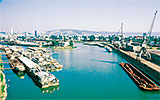Navigation
Historically the Danube and some of its main tributaries, such as the Sava, have formed important trade routes across Europe. The harnessing of these rivers to facilitate navigation has, however, radically changed their physical and ecological characteristics, while pollution from ships and boats is also a significant problem.
Did you know?
A single inland navigation vessel can carry the same volume of goods as 93 railway wagons or 173 trucks. The discharges of wastes and bilge water are forbidden. 1100 ships are registered at the Danube River - this is ten times less than in the Rhine River (navigable leng this ~1000km).
Various current plans designed to help shipping along the Danube are also a possible threat to the last remaining natural areas of the Danube and the region’s freshwater resources.
Facts and figures
Ships can navigate the Danube from 2,411 kilometres upstream all the way down to the Delta. This is 87% of the river's total length. The ships can call in at 78 harbours located along the Danube between Kelheim and the Black Sea.
The total length of the artificial dredged channels in the Danube Delta is roughly the same as the total length of natural water courses (1,700 km).
Pressures resulting from navigation
- Change of the natural river structure
- Changes to river courses, such as the blocking of connections to separate channels, tributaries and wetlands
- Disruption of natural flow patterns by hydromorphological alterations
- Hindering fish migration due to sluices
- Engineering works designed to remove sediments and clear channels
- Accidental pollution involving oil or hazardous substances
- Pollution by discharged bilge water, wastewater from tank washings and sewage from passenger boats
- Inadvertent introduction of invasive species
What the ICPDR is doing
The ICPDR linked up with the Danube Commission, and the International Commission for the Protection of the Sava River Basin to execute in 2007 an intense, cross-sectoral discussion process, which has lead to the `Joint Statement on Inland Navigation and Environmental Sustainability in the Danube River Basin´.
The Joint Statement provides principles and criteria for environmentally sustainable inland navigation on the Danube and its tributaries, including the maintenance of existing waterways and the development of future waterway infrastructure.
The process is involving selected representatives of navigation authorities, environmental protection authorities, industries and environmental organizations throughout the basin.
The Joint Statement is based on an interdisciplinary assessment of the following issues:
- What is the current status of inland navigation? What are the projects and plans for the future development? What are the limiting factors for inland navigation and waterway transport?
- What is the ecological situation of the Danube River Basin? What are the pressures and impacts resulting from navigation?
- How can the navigation sector help meet the requirements of the EU Water Framework Directive?
After its adoption in December 2007, the 3 commissions and all stakeholders agreed that the `Joint Statement´ should be used as a guiding document for the development of the `Programme of Measures´ requested by the EU Water Framework Directive, for the maintenance of the current inland navigation, as well as for the planning and the investments in future infrastructure and environmental protection projects.
The role of the EU
To improve transportation in Europe, the European Commission (EC) developed Trans-European Transport Networks (TEN-T) with guidelines for Pan-European road, rail, air and waterway transportation corridors. In 2003-2004, TEN-T guidelines newly designated the Danube as “Pan-European Transport Corridor VII”, becoming the “backbone of the east-west waterway connection” providing, together with the Rhine River, a link between the North Sea and Black Sea.
In order to further promote inland navigation transport the EC issued the “Integrated European Action Programme for inland Waterway Transport - NAIADES” in spring 2006. For its support, the EU PLATINA project (Platform for the Implementation of NAIADES) was started in 2008. Here, the ICPDR is responsible for the Sub-Work Package 5.3 Interdisciplinary Dialogue.
Disclaimer
The information contained in the ICPDR website is intended to enhance public access to information about the ICPDR and the Danube River. The information is correct to the best of the knowledge of the ICPDR Secretariat. If errors are brought to our attention we will try to correct them.
The ICPDR, expert group members, nor other parties involved in preparation of information contained on this website cannot, however, be held responsible for the correctness and validity of the data and information provided, nor accept responsibility or liability for damages or losses arising directly or indirectly from the use of the information conveyed therein.
Only those documents clearly marked ICPDR documents reflect the position of the ICPDR.
Any links to other websites are provided for your convenience only. The ICPDR does not accept any responsibility for the accuracy, availability, or appropriateness to the user's purposes, of any information or services on any other website.
When using the information and material provided on this website, credit should be given to the ICPDR.

